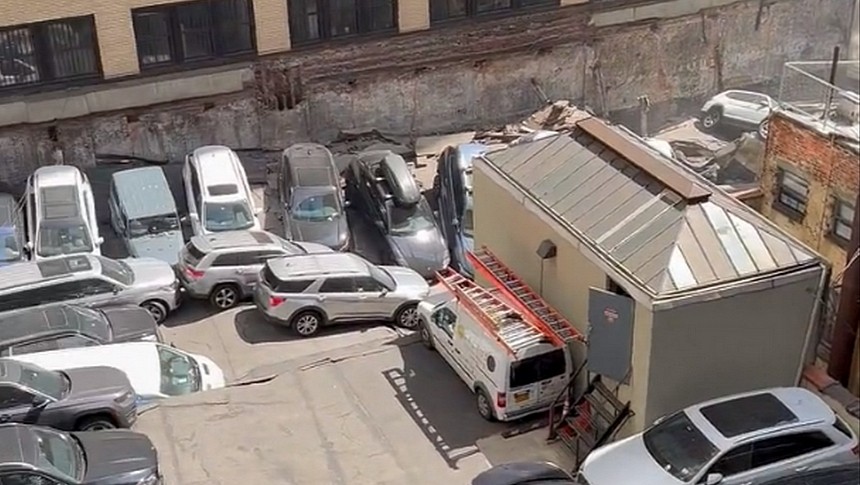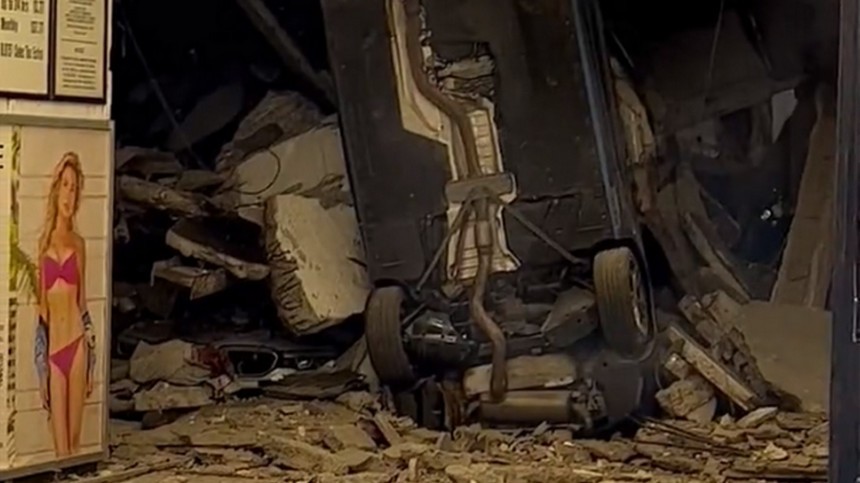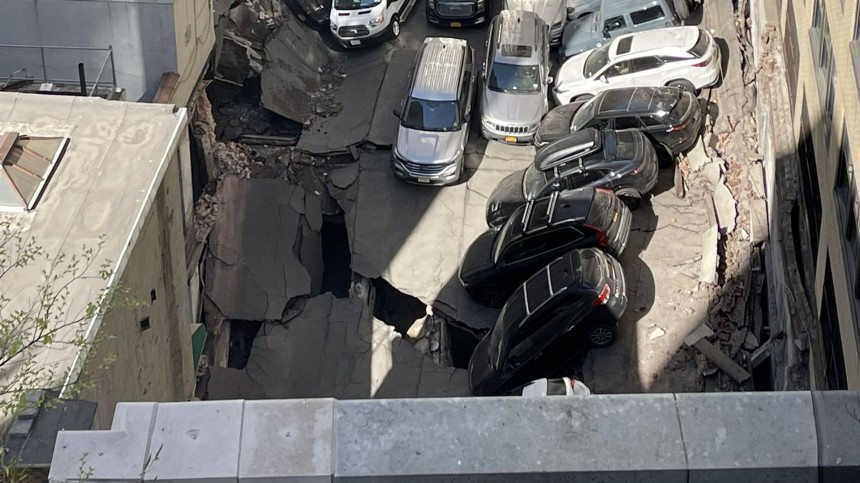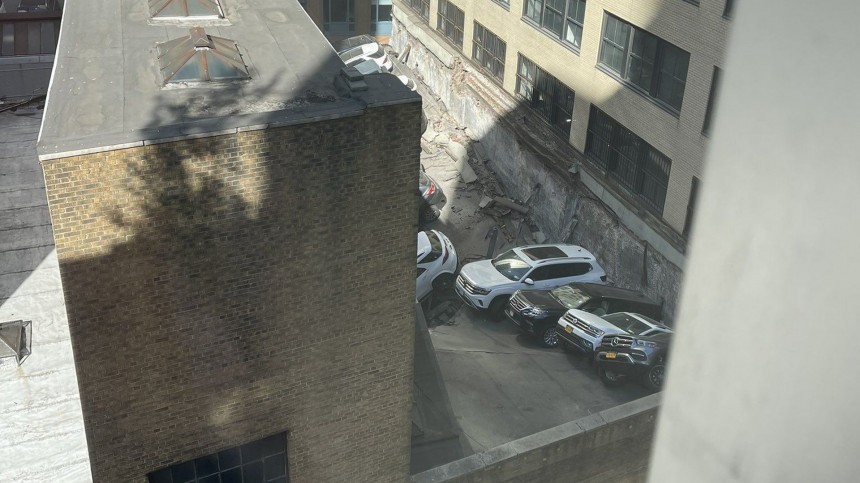On March 9, the Insurance Institute for Highway Safety (IIHS) made an alert about how heavy battery electric vehicles (BEVs) were getting and how that affected safety. On April 8, the British Parking Association said it feared old parking buildings would not stand BEVs when they were a majority. These precedents make a parking garage collapse in New York even more tragic than it already was.
On April 18, the Little Man Parking building collapsed at 57 Ann Street, New York. It was around 4:10 PM (local time) when the four-story structure "pancaked all the way to the cellar floor," as the Department of Buildings acting Commissioner Kazimir Vilenchik described what happened. Five people got hurt, and the location manager of the parking garage, Willis Moore, 59, died. He was about to leave his shift when the building collapsed.
The building collapse is still under investigation, but all images of the top of the 1920s construction show mostly SUVs. Although they are not as hefty as their BEV competitors, they are much heavier than ICE passenger vehicles. If that was enough to provoke a structural collapse, it is not difficult to imagine what would happen if all the cars parked in that building carried a massive battery pack.
Does that mean the blame is on the larger and more ponderous SUVs people love to drive nowadays? Not in this case. The New York Department of Buildings records show that the Little Man Parking had six open property violations, three of them deemed hazardous. It is unbelievable how old they are: 2003, 2009, and 2013. The newest one has ten years. The oldest celebrated its 20th 'birthday.' If they were hazardous, why weren't they enough to close the parking garage until the issues were solved?
The spotlights will be on Little Man Parking and Enterprise Ann Parking, respectively, the owner and the tenant of the parking garage that collapsed. However, the investigations will inevitably show that inspection and certification services are also to blame. If the building presented damages such as "defective concrete with exposed rear cracks" and "loose piece (sic) of concrete in danger of falling @ various locations," as the online violation reports disclose, why was this parking building allowed to operate?
Regardless of what this specific case involves, it is a scary tale of several other parking buildings in New York and around the world that were not even conceived to have that use. The building where Little Man Parking was installed was built in 1925 and turned into a parking garage in 1957. According to NBC News, the certification at the time allowed "more than five" vehicles to be parked on each floor but also said only passenger vehicles could be placed on the roof. The images show a van there apart from SUVs. Who was in charge of making sure these rules were enforced? Sadly, it is not possible to count on common sense: it is more unusual than its name suggests.
That said, the alerts we have heard from IIHS and the British Parking Association are now becoming as pressing as governments and environmental organizations urge us to buy BEVs. Unlike the slow but constant weight and size increase we have seen with combustion-engined vehicles, battery packs will impose an immediate and unavoidable mass expansion. While people are worried about charging infrastructure, what about buildings that can hold dozens of these BEVs when they are parked? What about the roads and bridges where they will circulate?
Concrete has an estimated lifespan of 50 years. While we do not learn to make Roman concrete – which proved it can resist for more than 2,000 years – and do not apply it everywhere, buildings already need constant and careful maintenance. Collapse reports may become more frequent if we stress these structures more than they were originally conceived to endure. In a way, the almost centenary parking garage that killed Moore lasted more than the average. Nobody can say it did not try to resist.
That said, the discussions about having to invest more money in charging infrastructure are, at the very least, incomplete. We'll need way more money for way more implications than we have been able to tell so far. A denser charging infrastructure will demand a more robust grid. A more robust grid will need to explore more carbon-neutral energy generation methods than just wind, solar, and hydropower. Creating massive dams to generate electricity also has enormous environmental impacts. Just try to learn more about the Belo Monte Dam to see what I mean. Heavier vehicles bring several safety and efficiency concerns that involve way more elements than just their direct impact on road users.
If we really are to pursue a heavier solution for personal transportation and intend to multiply it by millions or even billions, we need to evaluate very carefully all implications that can have and how much that will cost. The risk is that society will eventually think it is too expensive to deserve attention and run for collective answers as the only ones possible. They are not, but rushing to take shortcuts may make them look that way.
The building collapse is still under investigation, but all images of the top of the 1920s construction show mostly SUVs. Although they are not as hefty as their BEV competitors, they are much heavier than ICE passenger vehicles. If that was enough to provoke a structural collapse, it is not difficult to imagine what would happen if all the cars parked in that building carried a massive battery pack.
The spotlights will be on Little Man Parking and Enterprise Ann Parking, respectively, the owner and the tenant of the parking garage that collapsed. However, the investigations will inevitably show that inspection and certification services are also to blame. If the building presented damages such as "defective concrete with exposed rear cracks" and "loose piece (sic) of concrete in danger of falling @ various locations," as the online violation reports disclose, why was this parking building allowed to operate?
That said, the alerts we have heard from IIHS and the British Parking Association are now becoming as pressing as governments and environmental organizations urge us to buy BEVs. Unlike the slow but constant weight and size increase we have seen with combustion-engined vehicles, battery packs will impose an immediate and unavoidable mass expansion. While people are worried about charging infrastructure, what about buildings that can hold dozens of these BEVs when they are parked? What about the roads and bridges where they will circulate?
That said, the discussions about having to invest more money in charging infrastructure are, at the very least, incomplete. We'll need way more money for way more implications than we have been able to tell so far. A denser charging infrastructure will demand a more robust grid. A more robust grid will need to explore more carbon-neutral energy generation methods than just wind, solar, and hydropower. Creating massive dams to generate electricity also has enormous environmental impacts. Just try to learn more about the Belo Monte Dam to see what I mean. Heavier vehicles bring several safety and efficiency concerns that involve way more elements than just their direct impact on road users.
More shots of the #garagecollapse #fidi #nyc pic.twitter.com/6y03IAhKl5
— DaDa Rocks! (@dadarocks) April 19, 2023
FDNY members are operating at the scene of a parking garage collapse. 1 person is confirmed dead and 5 others were transported. Additional searches are underway. pic.twitter.com/wiXQxUrfLy
— FDNY (@FDNY) April 18, 2023












